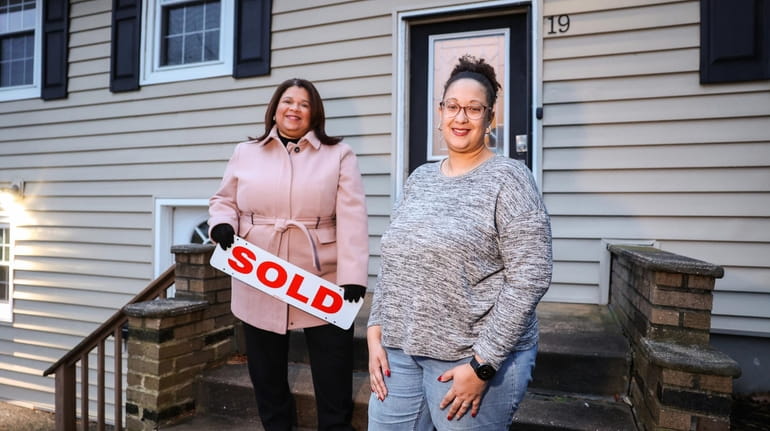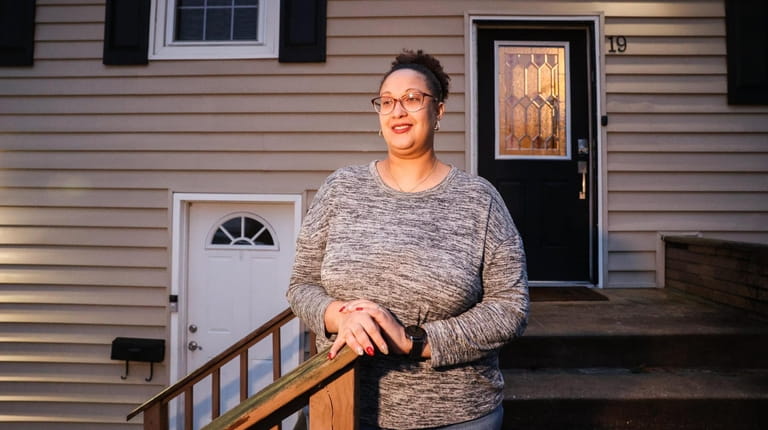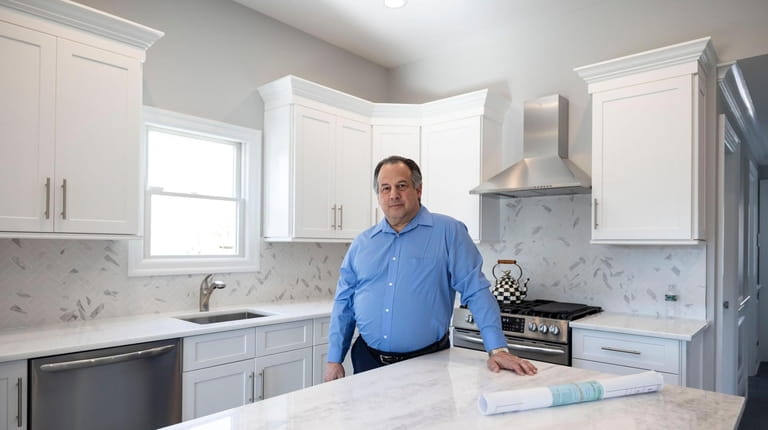The tough quest for mother-daughter homes on Long Island

Real estate agent Nancy Vargas-Johnson with Halima Armstrong at Armstrong's new home in East Patchogue, which has living space for her mother. Credit: Newsday/Steve Pfost
When her mother-in-law moved into the crammed two-bedroom rental in Lake Ronkonkoma in June where Halima Armstrong had been living with her family of four, she knew she had to find a larger place.
"We needed enough space for her and to not feel like we’re on top of one another, because she was in her own two-bedroom apartment in Maryland," says Armstrong, 40, a hospital administrative assistant.
After looking at about two dozen homes, the Armstrongs moved into a five-bedroom high ranch in East Patchogue in November. Now, Armstrong, her husband, son and daughter sleep in the three bedrooms of the upper level while her mother-in-law, Brenda Armstrong, 67, has one side of the first level — two bedrooms, a combined living room/kitchen area, bathroom, and separate entrance — to herself. Eventually, they’ll add a sink and cabinets to the mother-in-law suite, which was converted from the home’s garage. They purchased the home for $420,000, outbidding a buyer with an offer that was on the table.
"My mother-in-law is able to get [the kids] off the bus and stay with them until I get home," says Armstrong. "They run up and down and like, ‘Oh, let me see my grandma.’ So it’s convenient for everyone and everyone seems happy."
Low inventory

Halima Armstrong and her family moved to a house in East Patchogue that includes a two-bedroom space with a separate entrance for her mother, who helps care for her grandchildren. Credit: Newsday/Steve Pfost
There’s very little housing inventory in general and even fewer homes with two separate living quarters, says Nancy Vargas Johnson of Realty Connect USA, a buyer's agent who represented the Armstrongs.
They searched exclusively for a high ranch — a one-story home with a split-level entry that’s set on a raised foundation so that the main level is not subterranean. Another option, albeit less desirable, was a ranch with a basement converted into a second living space.
"We put offers on probably more than eight to 10 properties" that they were outbid on, says Vargas Johnson. "It took about six or seven months to find something."
It’s always difficult to find a mother-daughter set-up, says Vargas Johnson. "You have to get creative with the spacing,"
A mother-daughter home differs from a two-family home in that it requires that the residents in the home be related, says Marta Kane, a spokesperson for the Town of Oyster Bay. Legalizing a mother-daughter home requires a variance from the town’s Zoning Board of Appeals, which costs $225 and must be renewed every three years.
A two-family home, which has a separate living space for a nonrelative of the owner, also requires approval from the ZBA. Only permitted in certain residential zones, a two-family must be owner-occupied and on a parcel of land at least 12,000 square feet. The cost for a permit depends on the extent of renovations and, once approved, does not require renewal, notes Kane.
An arduous process
For a home that Michael Matrisciano, a real estate agent with Compass Real Estate, recently sold in Franklin Square, the transformation into a mother-daughter residence was an arduous, expensive five-year ordeal. The sellers had to complete multiple applications, supply documents, have a hearing with a judge in the Town of Hempstead, get 20 neighbors to sign a petition agreeing to the permit, hire an architect to do drawings, obtain plumbing and electrical certificates, and complete the construction — all at a total cost of about $35,000.
Despite the painstaking process, the sellers were happy with the results, notes Matrisciano, adding that the permit also allowed them to configure numerous vehicles in the driveway without violating town code. The town code permits a maximum of two cars for a single family home and up to four vehicles with a mother-daughter permit.
Even if a home is permitted as a mother-daughter, that permit expires with the sale of the house, and the new owners must reapply if they choose to use it as a mother-daughter.
"A lot of people do improvements to their houses and they don’t legalize it because they do make it very difficult for you," says Gina Fiorenze, a real estate agent with Compass Real Estate, adding that some banks won’t approve a mortgage if there’s an illegal apartment, and will insist that the extra kitchen be removed before they’ll offer a loan.
To legalize the home, the new owner has to have it inspected for carbon monoxide detectors, proper egress and ingress, and up-to-code plumbing and electric. The entire process could take anywhere from six months to a year. While you wait, Fiorenze says, you still can move everyone in, but you must legalize everything as soon as possible.
Houses should be listed for sale or rent as "possible mother-daughter with the proper permits," advises Fiorenze.
All under one roof

Architect Michael J. Palomba in the kitchen addition that he recently designed for a mother-daughter home in Massapequa. Credit: Newsday/Alejandra Villa Loarca
About four years ago Frank Maiello, 49, who is retired from law enforcement, asked his parents, who were living in Rockville Centre, to move into his wide-line ranch in North Massapequa. Anticipating future needs, Maiello and his parents agreed that co-habitating would be a better arrangement as they got older.
Maiello reached out to Michael J. Palomba, an architect based in Bethpage, to guide them through the process.
"I imagine trying to do it yourself, if you didn’t have somebody to steer you along, it could be complicated to figure it out," says Maiello.
Although it took just over a year from planning to a certificate of occupancy, everything went smoothly.
"I wasn’t expecting it to be that much quicker: We put a second floor on the house," Maiello says of the new level with four bedrooms and a bathroom. The section of the house that originally had three bedrooms is now a one-bedroom residence with a kitchen, living room and bathroom for his parents. The addition and renovation cost $200,000.
Now, Maiello says, it’s great to have his folks under the same roof.
"They have their independence, with their own space, but I like to have them close by," he says, adding that his four children are developing a close relationship with their grandparents. "For us, it’s been a blessing."
Every three years, they have to renew the permit, which they did for the first time in 2021 and which Maiello says wasn't too difficult. The original permit was $200; the renewal, $150.
'Quite a few offers'

Real estate agent Jatinder Singh at a home similar to one he found for a family looking for a mother-daughter set-up in Plainview. Credit: Debbie Egan-Chin
Last summer, Jatinder Singh, a real estate agent with La Rosa Realty New York, searched for a home for clients who were looking for a mother-daughter house in the Bethpage area.
"After looking at quite a few houses, I was able to find them a house in Plainview," says Singh of their four-week search. He found a high ranch for the couple, their three young kids and the husband’s parents.
On the ground-floor, there’s a kitchen, living room, bedroom and bathroom. The second floor has a living room, kitchen, dining room, three bedrooms and a bathroom.
"We made quite a few offers. It’s not easy — it's a very tight market right now," says Singh, adding that the buyers paid $810,000, just over the asking price.
Permits and costs
Architect Palomba, who worked with the Maiellos, also works as an expediter for people who are seeking to legalize the second kitchen in their home.
To get a permit, you must file plans and applications with the town's building department that show the location of the second kitchen, says Palomba.
“And then the building department will send you to the zoning board of appeals for an approval,” Palomba says. “You present the application to the zoning board for review. Once it’s approved, it goes back to the building department for the issuance of the permit and then you can add the second kitchen.”
The process could take four to six months — or even longer, notes Palomba.
In some cases, people will buy a house that already has a second kitchen, and they must legalize it by filing a new application for mother-daughter use, says Palomba. If the house had the proper permits, the new owner only has to file for a name change with the application and present newly drawn-up plans of the entire house.
Drawing plans and filing an application can cost between $1,750 and $2,000. The zoning board application would be an additional $1,500 to $2,000. For a new application, the homeowner will need a licensed electrician and plumber to do the work, and installing the kitchen could cost between $15,000 and $30,000.
If any work was done on the house without permits, the new homeowner will be responsible for permitting that as well, says Palomba.
“When you file an application, the building department usually reviews your file, and if there’s anything else outstanding, they could ask you to address that during the process,” he says.
— ARLENE GROSS
